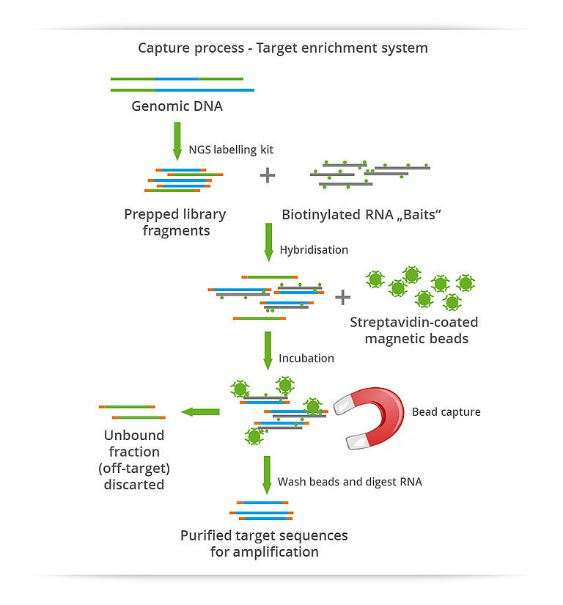Tracing back to the source: detailing the targeted resequencing and amplicon capture technology After the news of Thermo's cooperation with Illumina was announced, a blockbuster was dropped in the biomedical world, and Ion Ampliseq also became a hot search term. What is the technology of Ion Ampliseq? What is unique about it? Why is this technology causing a sensational effect? Let us trace the roots and start with NGS. NGS, the next-generation sequencing technology, also known as High-throughput sequencing, is capable of sequencing hundreds of thousands to millions of DNA molecules at a time but generally has a longer read length. Short for the logo. NGS technology is maturing year by year, which makes the cost of whole genome sequencing lower and lower, but the analysis of the extremely large and complicated data volume obtained by sequencing the whole genome has not become simpler. On the contrary, The higher the depth of sequencing, the resulting data volume becomes even larger, and the analysis becomes more difficult. Thus, the development of sequencing technology has two extreme directions: one is large and complete genome-wide sequencing, and the other is small and precise targeted resequencing. Compared to Whole Genome Sequencing (WGS), targeted resequencing techniques directly isolate and sequence genomic regions of interest from a sample. This method can take advantage of NGS technology more efficiently and economically, and the subsequent analysis speed will also be improved. For example, the exome only accounts for about 1% of the genome, but it contains most of the known pathogenic mutations. Separating the exon regions and sequencing them separately, subsequent analysis can reduce the workload by 99%. Greatly speed up the analysis. In the fields of genetic mutation, tumor screening, etc., the sensitivity that can be achieved by targeted resequencing is completely impossible to achieve by whole genome sequencing. Since targeted resequencing separates and enriches the target region of the gene before sequencing, a significant reduction in the target region can achieve a sequencing depth of 5000× or higher. An increase in sequencing depth means higher sensitivity (capable of detecting low frequency variations) with detection limits as low as 0.1%. , In targeted resequencing, enrichment of target fragments is achieved primarily in two ways: hybrid capture and amplicon capture. â—‹â—â—‹ Hybrid capture technology By designing a biotinylated probe complementary to the target fragment, it is hybridized with the fragment containing the gene of interest to achieve high-throughput sequencing after enrichment of the target gene fragment. According to the different supports, the probe hybridization capture technology is divided into liquid phase hybridization and solid phase hybridization. Solid phase hybridization has been largely eliminated due to its cost and operational disadvantages; liquid phase hybridization is in solution, the target fragment is directly hybridized with a biotinylated probe, and then coated with streptavidin. The magnetic beads adsorb the fragments of the hybrid biotin probe. After washing off the free DNA, the enriched DNA is amplified to construct a high-throughput sequencing library. â—‹â—â—‹ Amplicon capture technology Amplicon capture sequencing technology is a high-throughput sequencing technology for target regions. It uses specific primers to PCR-amplify the DNA region of interest to form a highly enriched DNA library. After purification of the PCR product, library construction is performed. And high-throughput sequencing. The Ion Ampliseq technique described in the first article is attributed to the amplicon capture technique. Amplicon capture sequencing boosts clinical research For clinical or translational research, testing is not only accurate, but also fast and economical. Compared with the amplicon capture method, the experimental process of hybridization capture is too complicated and cumbersome, and the manual operation time is too long. Excessive manual intervention process may have an uncontrollable effect on the experimental results, which is very deadly for clinical use. of. At the same time, the simplification of the amplicon capture technology experimental process greatly reduces the professional threshold of the operator, enabling more people to complete the experiment, completely liberating the risk of deficiencies. Amplicon capture sequencing is very useful as a complementary technology to genome-wide sequencing, which greatly simplifies the experimental process and analytical goals. This technology has proven to be a fast, efficient technology and unique in the next generation of high-throughput sequencing, and has produced many exciting new discoveries and applications. Original one-step amplicon building technology reshapes N GS technical attributes Qihui Bio Deep Plough Targeted Sequencing for many years, through the unique primer design modification technology, the amplicon capture technology and library construction were combined into one step reaction, and the EMS-LibTM one-step database construction technology was successfully developed. The technique has good homogeneity and amplification. Sub-copy number changes within 1 log, effectively avoiding over-sequencing; high specificity, accurate analysis data up to 99%; convenient operation, single-tube reaction, from capture to database construction, manual operation only 10 min. Based on the EMS-LibTM one-step database building technology, the following Panels have been developed: NINGBO MEDICAL EQUIPMENT CO.,LTD , https://www.techartmeds.com





